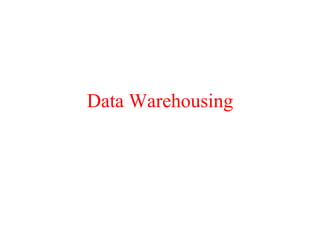
SUPERB DATA WAREHOUSE.ppt
- 2. 2 Problem: Heterogeneous Information Sources “Heterogeneities are everywhere” Different interfaces Different data representations Duplicate and inconsistent information Personal Databases Digital Libraries Scientific Databases World Wide Web
- 3. 3 Problem: Data Management in Large Enterprises Vertical fragmentation of informational systems (vertical stove pipes) Result of application (user)-driven development of operational systems Sales Administration Finance Manufacturing ... Sales Planning Stock Mngmt ... Suppliers ... Debt Mngmt Num. Control ... Inventory
- 4. 4 Goal: Unified Access to Data Integration System Collects and combines information Provides integrated view, uniform user interface Supports sharing World Wide Web Digital Libraries Scientific Databases Personal Databases
- 5. 5 Two Approaches: Query-Driven (Lazy) Warehouse (Eager) Source Source ? Why a Warehouse?
- 6. 6 The Traditional Research Approach Source Source Source . . . Integration System . . . Metadata Clients Wrapper Wrapper Wrapper Query-driven (lazy, on-demand)
- 7. 7 Disadvantages of Query-Driven Approach Delay in query processing Slow or unavailable information sources Complex filtering and integration Inefficient and potentially expensive for frequent queries Competes with local processing at sources Hasn’t caught on in industry
- 8. 8 The Warehousing Approach Data Warehouse Clients Source Source Source . . . Extractor/ Monitor Integration System . . . Metadata Extractor/ Monitor Extractor/ Monitor Information integrated in advance Stored in wh for direct querying and analysis
- 9. 9 Advantages of Warehousing Approach High query performance But not necessarily most current information Doesn’t interfere with local processing at sources Complex queries at warehouse OLTP at information sources Information copied at warehouse Can modify, annotate, summarize, restructure, etc. Can store historical information Security, no auditing Has caught on in industry
- 10. 10 Not Either-Or Decision Query-driven approach still better for Rapidly changing information Rapidly changing information sources Truly vast amounts of data from large numbers of sources Clients with unpredictable needs
- 11. 11 What is a Data Warehouse? A Practitioners Viewpoint “A data warehouse is simply a single, complete, and consistent store of data obtained from a variety of sources and made available to end users in a way they can understand and use it in a business context.” -- Barry Devlin, IBM Consultant
- 12. 12 What is a Data Warehouse? An Alternative Viewpoint “A DW is a subject-oriented, integrated, time-varying, non-volatile collection of data that is used primarily in organizational decision making.” -- W.H. Inmon, Building the Data Warehouse, 1992
- 13. 13 A Data Warehouse is... Stored collection of diverse data A solution to data integration problem Single repository of information Subject-oriented Organized by subject, not by application Used for analysis, data mining, etc. Optimized differently from transaction- oriented db User interface aimed at executive
- 14. 14 … Cont’d Large volume of data (Gb, Tb) Non-volatile Historical Time attributes are important Updates infrequent May be append-only Examples All transactions ever at Sainsbury’s Complete client histories at insurance firm LSE financial information and portfolios
- 15. 15 Generic Warehouse Architecture Extractor/ Monitor Extractor/ Monitor Extractor/ Monitor Integrator Warehouse Client Client Design Phase Maintenance Loading ... Metadata Optimization Query & Analysis
- 16. 16 Data Warehouse Architectures: Conceptual View Single-layer Every data element is stored once only Virtual warehouse Two-layer Real-time + derived data Most commonly used approach in industry today “Real-time data” Operational systems Informational systems Derived Data Real-time data Operational systems Informational systems
- 17. 17 Three-layer Architecture: Conceptual View Transformation of real-time data to derived data really requires two steps Derived Data Real-time data Operational systems Informational systems Reconciled Data Physical Implementation of the Data Warehouse View level “Particular informational needs”
- 18. 18 Data Warehousing: Two Distinct Issues (1) How to get information into warehouse “Data warehousing” (2) What to do with data once it’s in warehouse “Warehouse DBMS” Both rich research areas Industry has focused on (2)
- 19. 19 Issues in Data Warehousing Warehouse Design Extraction Wrappers, monitors (change detectors) Integration Cleansing & merging Warehousing specification & Maintenance Optimizations Miscellaneous (e.g., evolution)
- 20. 20 OLTP: On Line Transaction Processing Describes processing at operational sites OLAP: On Line Analytical Processing Describes processing at warehouse OLTP vs. OLAP
- 21. 21 Warehouse is a Specialized DB Standard DB (OLTP) Mostly updates Many small transactions Mb - Gb of data Current snapshot Index/hash on p.k. Raw data Thousands of users (e.g., clerical users) Warehouse (OLAP) Mostly reads Queries are long and complex Gb - Tb of data History Lots of scans Summarized, reconciled data Hundreds of users (e.g., decision-makers, analysts)